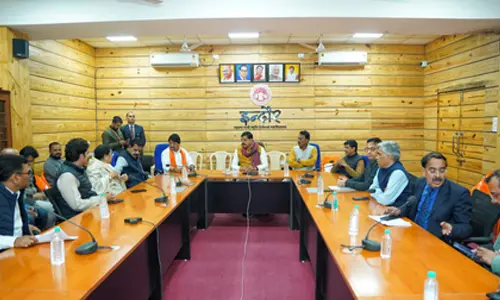Not-traceable not acceptable under RTI

Not-traceable not acceptable under RTI. ‘Files are missing’, or ‘records not traceable’ or ‘papers are scattered’ are the usual defences we hear from the Public Information Officers in response to the request for information under the RTI Act.
First Telugu RTI Adjudication on Polavaram
The appellant complained that official website of Union Ministry of Environment and Forests does not have the information as required by Section 4 (1) (b) of RTI Act in the same manner as such information was available regarding other projects. He alleged grave negligence and contravention of the RTI Act. He also questioned the lame excuse that the record sought was ‘decade old’ and the documents were scattered.
This itself indicates utter failure of the Union Ministry in keeping the precious public records of a significant project to which the government accorded national status. This is violation of the provisions of the Public Records Act which mandates proper arrangement, maintenance and preservation of the public records
‘Files are missing’, or ‘records not traceable’ or ‘papers are scattered’ are the usual defences we hear from the Public Information Officers in response to the request for information under the RTI Act. To our great fortune, these were not recognised as ‘defences’ or ‘exemptions’ to the disclosure of information under any access law in the world, much less in Right to Information Act, 2005.

These are the defences argued by the Union Ministry of Environment and Forests when a Telugu person sought to know the details of ‘national multipurpose project’ Indira Sagar, which is popularly known as Polavaram. The significance and controversial character of Polavaram need not be reiterated. It is contentious between two Telugu States and also between Andhra Pradesh and Chhattisgarh and Odisha. The proposed Polavaram Project is conceived as a multipurpose project conferring irrigation benefits to an extent of 7.20 lakh acres in the upland area of West Godavari, Krishna, East Godavari and Visakhapatnam districts, 21 cumecs drinking water supply, 1.8 x 10 cum/day industrial water supply and generation of Hydel Power with an installed capacity of 960 mw.
The project site is located at 42 km upstream of Sir Arthur Cotton Barrage near Polavaram village of the River Godavari. The proposed dam involves displacement of nearly 1,17,034 people of different ethnic groups in 276 villages and submersion of 38,186 hectares in nine mandals of West Godavari, East Godavari in AP and Khammam in Telangana. Thirteen villages in Chattisgarh and 10 villages in Odisha are likely to be submerged and about 3222.35 hectares of forest land is coming under submergence, the letter stated.
D Suresh Kumar on June 12, 2014, sought details of environmental clearance to Indira Sagar Polavaram project in West Godavari District, AP. Claiming non-furnishing of information within a month the appellant filed the First Appeal. The First Appellate Authority stated that the information sought was voluminous, however, he directed the PIO to make all efforts to trace the record and provide the relevant information within 7 days. Against non-compliance, the appellant approached the CIC.
The appellant complained that official website of Union Ministry of Environment and Forests does not have the information as required by Section 4 (1) (b) of RTI Act in the same manner as such information was available regarding other projects. He alleged grave negligence and contravention of the RTI Act. He also questioned the lame excuse that record sought was ‘decade old’ and the documents were scattered. This itself indicates utter failure of the Union Ministry in keeping the precious public records of a significant project to which the government accorded national status. This is violation of the provisions of the Public Records Act which mandates proper arrangement, maintenance and preservation of the public records.
The CPIO, Dr P V Subba Rao, who is also environmental scientist, and Deputy Director explained that delay was unintentional, due to other exigencies of the works in River Valley and HEP programmes like court cases before the Supreme Court, National Green Tribunal and the High Court, time-bound parliament related work etc. The contention of the appellant that the “failure to trace records” would not exempt the public authority from their duty to provide the information sought is absolutely correct. The CPIO pleaded that due to shifting of office, lack of necessary staff including a typist & peon and he being all alone could not collect these documents due to other pressing project works entrusted to him. The CPIO also expressed regrets for the delay and promised the appellant to provide all the information and also exchanged mobile numbers with him.
He said environmental clearance for survey and investigation was given long back and the officials had to revisit the clearance because of changes and developments. The official website contained all updated information about all projects and minutes of important meetings regarding Polavaram were also placed, though some minutes regarding earlier period need to be computerised. He assured that the website will be updated with latest information whenever new decisions are taken. The MoEF provided a copy of letter from Additional Director Dr S Bhowmik, written to Secretary of Andhra Pradesh on September 19, 2005, stating that the Union Ministry accorded site clearance for investigation and survey as per the provisions of Environment Impact Assessment (EIA) Notification, with some conditions.
One of the conditions is that a comprehensive EIA report comprising the detailed report on ecological study, command area development, water logging, cropping systems, rehabilitation and resettlement, seismicity, disaster management plan, minerals, infrastructure related reports within 18 months. The letter also suggested including suggestions arising out of public hearing. It also clarified that clearance is only for undertaking investigations and for collection of environmental data for preparation of comprehensive EIA report and management plans, and that this clearance should not in any way be construed as commitment for environmental clearance of any hydroelectric project at the site. No civil work of permanent nature on the project shall be initiated in anticipation of final approval.
The project authority would have to apply for environmental clearance by submitting environmental data and plans. Forest clearance should be obtained for acquisition of forest land. Bhowmik’s letter stated that the Union Ministry reserved the right to suggest additional measures for environmental protection during investigation stage, if found necessary. For the first time in the CIC, this Commissioner conducted hearing in Telugu language and gave order in Telugu along with English order, as the appellant, the CPIO (besides me and my PS) happened to know Telugu. D Suresh Kumar, participated through Video Conference from Hyderabad, the combined capital of two Telugu states.
I have directed the Union Ministry of Environment and Forests to provide copies of correspondence between the Ministry and the states of Andhra Pradesh (before division) Odisha and Chhattisgarh within one month along with file notings and copies of files relating to clearances given in 2005 and also about revisiting of clearance recently. I have also directed MoEF to place all available information of Polavaram project in their official website as per Section 4 (1) (b) subject to Section-8 so that information requirements are effectively answered because Polavaram was declared as National Project being very significant for Andhra Pradesh, Telangana, Odisha and Chhattisgarh.














